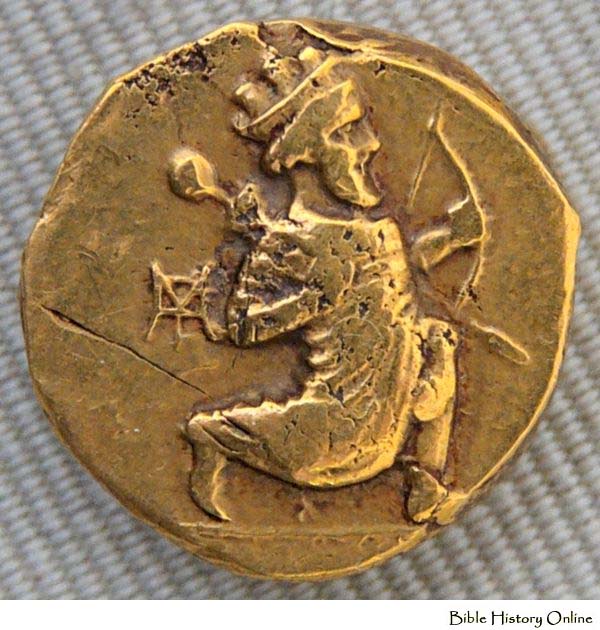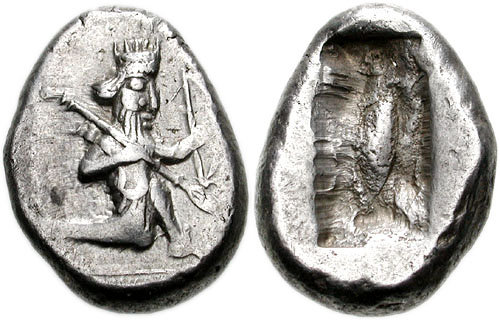The coinage of the Achaemenid Empire was a continuation of the coins of Lydia.The Persians, like the Medes and Babylonians, were unfamiliar with, or felt not need of, coined money before the capture of Sardes by Cyrus and the conquest of the Lydian empire B.C. 546, when for the first time they came into direct contact with the Greeks of the coast lands of Asia Minor. How soon after these events they began to issue gold staters of the royal Persian type is a somewhat doubtful point, but the Darius Hystaspis, B.C. 521-486, coined gold money of the finest quality- we are told by Herodotus. Coins were introduced by Darius the Great and were issued from 520 BCE-450 BCE all up to the time of Alexander the Greats conquest in 330 BCE/ it goes for the Daric and Siglos. It seems that before then, a continuation of Lydian coinage under Persian rule was highly likely . Achaemenid coinage includes the official imperial issues (Darics and Sigloi), as well as coins issued by the Achaemenid governors (Satraps), such as those stationed in ancient Asia Minor.

Darius first introduced a reform currency
system at about 520-480, the precise period is debatable. The rate of
exchange was 1 Daric = 20 Siglos. It consisted of a Daric of between
8.10-8.50 grams in weight and based on the Babylonian shekel of 8.33 grams. The purity was between 98-99% gold.
It
seems probable, therefore, that the gold Daric was first struck in the reign
of Darius, and moreover at the Sardian mint, which may then have been reopened
after having
been closed since the fall of Croesus, for it is hardly likely
that either Cyrus or Cambyses would have allowed it to continue the issue
of the Croesean gold staters after the Persian conquest. That Sardes should
be place of mintage chosen by Darius for his new Persian coinage is not surprising,
when it is borne in mind that the processes of minting were fully understood
there, and that skilled die-sinkers and moneyers would be more easily obtainable
there than anywhere else in the Persian empire.
After the capture of Babylon by Alexander, the Satrap Mazaios issued the double Daric of 16.65 grams in weight whose image was based on the Daric coin and bore his name until his death in 328 BCE. 1 Daric = 25 Attic Drachmae.

Double Daric
In the ancient times, it was nicknamed "the archer". For instance, Agesilaus said that he had been driven out of Asia by thirty thousand archers, referring to the bribe distributed by the Persian King.
In the ancient times, it was nicknamed "the archer". For instance, Agesilaus said that he had been driven out of Asia by thirty thousand archers, referring to the bribe distributed by the Persian King.
Some, such as the Ancient Greeks, believed that this coin's name is derived from the name Darius, but in reality it appears to be derived from a Persian word meaning "gold"; in Middle Persian it is called zarig.
Siglos-silver coin

Silver siglos-4th century BC
Siglos is 5.40-5.60 grams each, but is based on the 0.5 Lydian Siglos of 10.73-10.92 grams for the full unit. Purity was at first issue 97-98% but by the middle 4th century was 94-95%. 1 Siglos = 7.5 Attic Obols
The coin is mentioned several times in the Old Testament, as the Israelites came into contact with it when their Babylonian conquerors were conquered by Persia. The first 'Book of Chronicles' describes king David as asking an assembly of people to donate for the construction of the Temple. The people gave generously "for the service of the house of God five thousand talents and ten thousand darics of gold, ten thousand talents of silver, eighteen thousand talents of bronze, and one hundred thousand talents of iron.
Regarding Persian coinage
It seems probable, therefore, that the gold Daric was first struck in the reign of Darius, and moreover at the Sardian mint, which may then have been reopened after having been closed since the fall of Croesus, for it is hardly likely that either Cyrus or Cambyses would have allowed it to continue the issue of the Croesean gold staters after the Persian conquest. That Sardes should be place of mintage chosen by Darius for his new Persian coinage is not surprising, when it is borne in mind that the processes of minting were fully understood there, and that skilled die-sinkers and moneyers would be more easily obtainable there than anywhere else in the Persian empire.
The output of the darics during the reigns of Darius and Xerxes, doubtless from other centres as well as from the old Sardian mint, must have been enormous, for we read that the Lydian, Pythius, at the time of the expedition of Xerxes, possessed as many as 3,993,000 of them, a sum which the king increased to 4,000,000.
Following the example set by Croesus, Darius employed practically pure gold for his new coinage, though with the addition of about 3 per cent. of alloy which, as experience had taught the moneyers, was necessary for slightly hardening of the metal. The weight of the Daric, 130 grs., was rather heavier than that of its predecessor the Croesean stater (126 grs.) by about 4 grs.,an excess partly, perhaps, due to the 3 per cent. of alloy added to the pure metal. It may be doubted, however, whether the intrinsic value of the Daric exceeded that of the stater of Croesus, which was of absolutely pure gold.
No comments:
Post a Comment